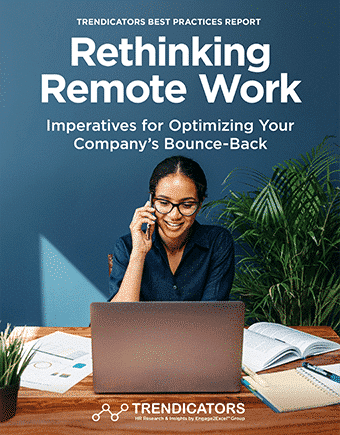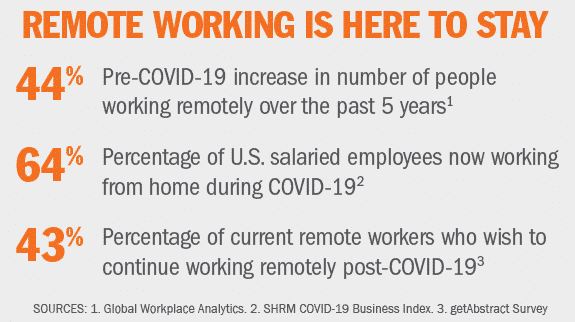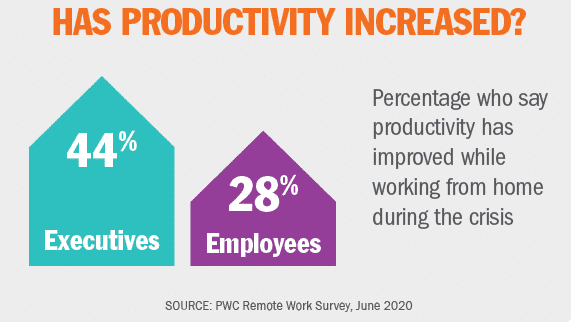Rethinking Remote Work

C-Suite Perspectives
Why and how leaders are rethinking their corporate cultures
Early notions of a V-shaped recovery have been replaced by two fundamental realizations. We are in for a prolonged period of recovery, and companies across all sectors need to rethink supporting and engaging remote workers. As with all setbacks, opportunities exist for organizations to reexamine and improve corporate culture. The COVID-19 crisis has profoundly changed how companies, employees and customers think about relationships. The quotes below reflect several C-suite viewpoints on remote work. What is your company’s perspective? Has it been clearly communicated to employees? On the following pages, we’ll explore some of the challenges and opportunities for improving your company’s culture and bounce-back strategy.

Tobi Lutke, CEO, Shopify
“A common misconception about company culture is that if you have a good one, you have to hold on to it. I believe this to be wrong. If you want to have a great culture, the trick is to evolve it forward with your environment. Take the best things with you from version to version. COVID is challenging us all to work together in new ways. We choose to jump in the driver’s seat, instead of being passengers to the changes ahead. We cannot go back to the way things were. This isn’t a choice; this is the future.”

Mark Zuckerberg CEO, Facebook
“We’re going to be the most forward-leaning company on remote work at our scale,” Zuckerberg says. “We need to do this in a way that’s thoughtful and responsible, so we’re going to do this in a measured way. But I think that it’s possible that over the next five to 10 years — maybe closer to 10 than five, but somewhere in that range — I think we could get to about half of the company working remotely permanently.”

Richard Branson Chairman and Founder, Virgin
“We like to give people the freedom to work where they want, safe in the knowledge that they have the drive and expertise to perform excellently, whether at their desk or in their kitchen. [I’ve] never worked out of an office, and never will.”

Katie Burke Chief People Officer, HubSpot
“Do you want to access talent everywhere, or just in specific markets? If the answer is everywhere, you need to be at least open to the possibility of remote work — it opens doors to attracting and retaining talent around the world, literally and figuratively.”
Download
 hbspt.cta.load(123973, '3e6533e1-3a4b-42f4-9c78-0d67eb1481d0', {});
hbspt.cta.load(123973, '3e6533e1-3a4b-42f4-9c78-0d67eb1481d0', {});
Remote Work Realities
New challenges to productivity must be addressed
Many technology companies have experienced significant stock market gains during the COVID-19 crisis. Providing remote workers with the technology they need to be productive is vital. However, a far greater challenge exists in addressing the emotional needs and interactive routines of employees who are new to working from home. Many employees (43%) who work from home now wish to continue working remotely after the crisis subsides. But differences of opinion exist regarding productivity impact.
Among executives, 44% believe that productivity has improved during the pandemic compared with 28% of employees who say they are more productive working from home. Addressing the challenges of remote work is essential for optimizing performance in the near future.


Dedicated Workspace
The lack of a dedicated workspace makes working from home frustrating and inefficient. Many companies have offered bonuses of up to $1,000 to help employees get set up.
Interruptions & Obligations
Working from home means more distractions—from the child who needs attention to a barking dog. A dedicated workspace helps. But added support and flexibility for work-life balance is needed.
Fatigue & Time Management
Screen fatigue and virtual-meeting overload leads to decreased attention span. Longer days are inevitable. Many employees need help to avoid burnout.
Communication & Collaboration
Virtual interaction lacks the subtle cues that improve communication and collaboration efficiency. New norms and ground rules are needed to enable productive interactions.
Download
 hbspt.cta.load(123973, '3e6533e1-3a4b-42f4-9c78-0d67eb1481d0', {});
hbspt.cta.load(123973, '3e6533e1-3a4b-42f4-9c78-0d67eb1481d0', {});
Bridging the Distance
What managers need to do differently to engage remote workers
The relationship between managers and their direct reports has undergone severe stress testing during the COVID-19 crisis. Unfortunately, 58% of managers have never received training in people management, according to a Career Builder survey. HR leaders should not expect that managers are well equipped to support remote employees. Every manager needs to reevaluate their role, pivot from supervising to enablement, sharpen listening skills and develop new routines to help remote employees overcome challenges. Best practices include structured check-ins, multiple communication options, creating virtual opportunities for social interactions and providing ongoing emotional support and understanding.
Reevaluate the Managerial Role
Many managers are accustomed to exercising control over how work gets done. When employees are working from home, this level of control isn’t possible. Effectively managing remote teams requires different skill sets. It is vital to understand the unique needs and challenges of each direct report and find new ways to help each individual succeed.
Improve Active Listening Skills
For one-on-one and group interactions in virtual settings, active listening skills are needed to maximize participation and ensure effective communication. When concerns or challenges are expressed during meetings, summarize and restate them to achieve clarity. Keep meetings and attendees focused by prohibiting texting and multi-tasking.
Become an Employee Enabler
Research conducted by Dr. Jack Wiley, Engage2Excel’s Chief Scientific Officer, reveals that a top priority for what employees want most from their managers is to “show support and understanding.” This has never been more important than now. Employees are feeling anxious and disconnected. Without on-site interaction, managers need to do one-to-one touch- base sessions and ask, “How can I help?”
Focus on Results Not Processes
Without direct oversight or control over how employees are getting their work done at home, managers should focus on outcomes and results. Employees who are less self-directed may need assistance in structuring their work. Get buy-in from everyone on the benefits of virtual meetings and don’t overlook the importance of using video for social interaction as well.
Download
 hbspt.cta.load(123973, '3e6533e1-3a4b-42f4-9c78-0d67eb1481d0', {});
hbspt.cta.load(123973, '3e6533e1-3a4b-42f4-9c78-0d67eb1481d0', {});
Reimagining Recognition
Creative ways to boost engagement and social connections
The pandemic has taken a significant toll on the emotional well-being of employees. Widespread economic uncertainty and a death toll in the United States that’s expected to exceed 200,000 by October has made mental health a top concern for employers. Employees are worried about job security, the challenges of working remotely and balancing job responsibilities with childcare, elder care and other personal obligations. In-person interactions have always played an important role in facilitating engagement, a sense of belonging and social connections in the workplace. Innovators are finding creative and fun new ways to boost engagement and social connectivity when working in a shared physical space isn’t possible.
Make Employee Milestones Memorable
Employees overwhelmingly crave recognition for career milestones and accomplishments. To create a sense of excitement and importance around such events, innovators are mailing elaborately wrapped packages to their employees’ homes; when they check their mail, employees find a parcel marked “Do Not Open Until (date and time).” What’s inside? Everything from confetti bombs to audio recordings of the CEO and yummy treats. Don’t settle for a boring Zoom session. Make your next recognition ceremony virtually unforgettable.
Spice Up Weekly Meetings
Establishing a regular cadence for virtual team meetings helps everyone feel connected. But these days, we’re all suffering from an overdose of online sessions. To spice things up, managers are integrating games, team-building exercises, stretching exercises and all sorts of contests in their meetings. Uber Eats and Door Dash have made it easy to cater to these kinds of meetings, and what better way to end the week than with a virtual cocktail hour?
Get Creative with Social Interactions
Informal interactions play an important role in overcoming feelings of isolation when working from home. Does your company have a eCard program for peer-to-peer recognition? Invite employees to liven things up with fun and funny eCard ideas. Encourage employees with strong relationship skills to check in on those that may be struggling. And don’t forget to reward employees who help build team spirit.
Download
 hbspt.cta.load(123973, '3e6533e1-3a4b-42f4-9c78-0d67eb1481d0', {});
hbspt.cta.load(123973, '3e6533e1-3a4b-42f4-9c78-0d67eb1481d0', {});
Realigning Recruiting
New opportunities for a talent-driven bounce-back
Resilient organizations recover quickly from adverse market conditions and fast-moving disruptions. A resilient talent acquisition strategy is critical for optimizing bounce-back. Our Trendicators survey of HR leaders in May revealed that 43% of organizations planned on ramping up hiring efforts in Q3 and Q4, with 47% expecting their talent acquisition budget to increase to support these efforts. Here are a few ideas for realigning your recruitment to take advantage of the significant opportunities for recruiting remote workers in today’s marketplace.
What is Your Virtual Brand Persona?
Experienced recruiters are accustomed to engaging and assessing candidates’ video interactions. Hiring managers, however, need coaching. Help your hiring team make a great virtual impression with support for composing the right background, finding a flattering camera angle and dressing appropriately. Conduct mock interviews to improve online interviewing skills, personal interactions and confidence.
Assessing Remote Capabilities & Experience
When interviewing a candidate who will be working remotely, whether full or part-time, a dedicated workspace and broadband access are essential. Beyond the knowledge, skills and abilities needed to do the job, assessing remote capabilities is important. Does the candidate communicate effectively via video? Did real-life interruptions occur during the interview? Do they possess the drive and discipline needed to work autonomously and unsupervised?
Setting Expectations & Creating Connections
Based on where the candidate is in the hiring journey, set expectations at the onset of every exchange. Be forgiving if you’re catching a candidate on the fly. Explain what’s going to happen and what to expect at the start of the conversation. Making candidates feel comfortable is key. A dialogue via video is a two-way collaboration. Draw candidates out to create connections and opportunities for meaningful exchange.
Broadening Your Talent Pool
Recruiting for remote roles in a period of double-digit unemployment presents an opportunity to fill important skills gaps. By removing geographic requirements, you now have access to a much broader and deeper pool of top performers. Also, consider your succession planning needs. The stock market’s current performance poses a risk for boomer-heavy organizations; boomers who couldn’t retire in the last recession may soon be leaving in droves.
Download
 hbspt.cta.load(123973, '3e6533e1-3a4b-42f4-9c78-0d67eb1481d0', {});
hbspt.cta.load(123973, '3e6533e1-3a4b-42f4-9c78-0d67eb1481d0', {});
Remote Onboarding
Ideas for accelerating time-to-productivity
Before the pandemic, many companies realized that their onboarding programs ineffectively integrated new employees into the corporate culture. Our 2019 Job Seeker Survey Report revealed that 41% of individuals would respond to a poor onboarding experience by immediately looking for another job. Completing paperwork, reviewing benefits and other HR administration requirements are essential, but effective onboarding programs are highly structured learning experiences designed to get new employees up to speed quickly. Just as hiring managers need help adapting to virtual recruiting, supervisors who conduct remote onboarding will also require support. Simply assuming that they’ll get it right can result in low productivity and high turnover at a time when your company can least afford it.
Focus on Time-to Productivity
While you want all new employees to feel welcome and excited about joining your organization, an onboarding program’s primary objective is to accelerate time to 100% productivity. Accomplishing this without in-person interactions takes careful planning, clear goals and a step-by-step agenda that outlines the processes, tasks and skills in need of development.
Implement a Buddy System
The onboarding experience will help in establishing a working relationship between employees and supervisors. Assigning a mentor or buddy gives new employees someone to talk to when they’re uncertain. Good mentors will help new employees understand what their days will be like, which helps accelerate their integration into the organization.
Enable Structured Learning
A highly structured program is needed for conducting remote interactions between supervisors and their coworkers. Clear milestones need to be defined, as do processes for validating comprehension at each stage. It is also important for all involved in the onboarding process to provide ongoing positive feedback and recognition to every new employee in order to maximize engagement.
Gamify to Increase Retention
When employees practice doing a task, learning success rates are more than twice as high as when the task is demonstrated for them. Give employees task-oriented assignments like sending them on a scavenger hunt to locate resources or completing a hypothetical assignment to improve retention and develop the acumen required to be productive.
Download
 hbspt.cta.load(123973, '3e6533e1-3a4b-42f4-9c78-0d67eb1481d0', {});
hbspt.cta.load(123973, '3e6533e1-3a4b-42f4-9c78-0d67eb1481d0', {});
Assessing Evolving Attitudes
Use pulse surveys to stay on top of employee perceptions
Pulse surveys are an effective tool for understanding employee mindsets during the COVID-19 recovery period. Consisting of a short set of questions on a single topic, pulse surveys should take no longer than five minutes to complete. These easy-to-create-and-field surveys can be used to identify what employees may need to work more effectively from home or to source recommendations for new policies and programs. Pulse surveys can also be used to gauge how employees rate their mental well-being or whether they feel they’re receiving too little, too much or just the right amount of communication from corporate leadership.
Don’t Survey If You Don’t Plan To Take Action
In times of crisis or periods of rapid change, two-way communication is essential. Unfortunately, many companies make the mistake of surveying employees without acknowledging or acting on results. This one-way communication mindset can only heighten anxiety during the COVID-19 recovery period. If your leadership team isn’t prepared to act on the results of a pulse survey, don’t bother conducting one.
Customize Questions To Address Key Concerns
All survey providers and platforms offer templates you can use for pulse surveys. But if the questions you ask employees sound canned or don’t reflect the issues and concerns of importance to your workforce, the results you’ll get aren’t likely to be actionable. The best way to ensure the relevance of your questions is to engage a representative group of employees in the survey’s development.
Share Pulse Survey Findings
Throughout this publication, we’ve discussed the importance of creating emotional connections with employees who work remotely. Sharing key findings from pulse surveys is an important way to let employees know that the company cares about their well-being, is listening to their concerns and is committed to creating a more empathetic and inclusive culture.